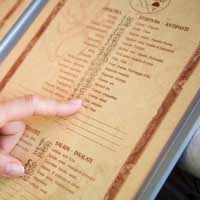Exchange Type vs Fixed Menu Diets

What is a Fixed Menu Diet Plan?
A fixed-menu diet provides a list of all the foods you should eat and their calorific value. The benefit of this type of diet plan is that is that you can follow it virtually without thinking because the meal plans are supplied for you. However, the downfall of this diet is that it is easy to become bored with such a restrictive menu plan; it also doesn't teach you how to be more selective of the more healthy foods yourself. This is problematic because it can mean that you regain your lost weight once the diet is over. For these reasons many people prefer the exchange type diet.What is an Exchange Type Diet?
An exchange-type diet is a specific meal plan which is arranged by a set number of servings from each of several food groups. Foods within each group are of equal measure in terms of calories and nutrients. The main benefit of this is that you can interchange them as you choose so that you can have more variety within your daily meals. Exchanges type diets help you to familiarise yourself with the food varieties and their nutritional values which will help you maintain a healthy diet and a healthy weight.How to Use the Exchange Type Diet
An exchange type diet is easy to manage once you get used to the caloric values of the foods on your exchange lists. For example, the "starch" category could include one slice of bread or 1/2 cup of oatmeal; each is about equal in nutritional value and calories. If your meal plan calls for two starch choices at breakfast, you could choose to eat two slices of bread, or one slice of bread and 1/2 cup of oatmeal.A Sample Food Exchange List
Vegetables contain 25 calories and 5 grams of carbohydrate. One serving equals:
- 230 grams Raw vegetables or salad greens
- 115 grams Cooked vegetables
- 120 ml Vegetable juice
Fat-Free and Very Low Fat Milk contains 90 calories per serving. One serving equals:
- 240 ml Fat-free milk or 1% fat
- 175 grams Plain non fat or low fat yoghurt
- 230 grams Artificially sweetened yoghurt
- 28 grams Turkey breast or chicken breast, without skin
- 28 grams Fish fillet (flounder, sole, scrod, cod, etc.)
- 28 grams Canned tuna in water
- 28 grams Shellfish (clams, lobster, scallop, shrimp)
- 175 grams Cottage cheese, non fat or low fat
- 2 Egg whites
- 28 grams Fat-free cheese
- 115 grams Beans- cooked (black beans, kidney, chick peas or lentils): count as 1 starch/ bread and 1 very lean protein
- 1 small Apple, banana, orange, nectarine
- 1 medium Fresh peach
- 1 Kiwi
- ½ Grapefruit
- ½ Mango
- 230 grams Fresh berries
- 230 grams Honeydew melon
- 28 grams Chicken- dark meat, without skin
- 28 grams Salmon, swordfish, herring
- 28 grams Dark turkey meat, without skin
- 28 grams Lean beef (flank steak, London broil, tenderloin, roast beef)
- 28 grams Lamb, roast or lean chop
- 28 grams Pork, tenderloin or fresh ham
- 28 grams Mozzarella cheese
- 1 Whole egg
- 28 grams Beef (any prime cut), corned beef, ground beef
- 112 grams Tofu
- 1 slice Bread (white, pumpernickel, whole wheat, rye)
- 2 slices Reduced calorie or "lite" Bread
- 1 Small bagel
- ½ Hamburger bun
- 76 grams Brown or white cooked rice
- 76 grams Barley or couscous, cooked
- 76 grams Dried beans, peas or lentils, cooked
- 115 grams Cooked pasta
- 115 corn, Sweet potato or green peas
Related Articles in the 'Controlling the Calories' Category...


Re: Reducing Fat and Building Muscle
Since manuscripts are subject to deterioration
Re: Is Coriander Juice Useful for Weight Reduction?
i want loss my lower body weight like belly hips weight it drink help me for loss weight its possible so…
Re: Is Coriander Juice Useful for Weight Reduction?
I want to reduce my Weight 10kgs with any proper diet please suggest something.
Re: Is Coriander Juice Useful for Weight Reduction?
I want to loose my belly fat in one week but without dieting. Does coriander juice will work?
Re: Advantages and Disadvantages of a Low-fat Diet
Why is this website titled advantages and disadvantages of a low-fat diet if it says nothing about that. I…
Re: Is Coriander Juice Useful for Weight Reduction?
So is it unhealthy? I started drinking it today...
Re: Is Coriander Juice Useful for Weight Reduction?
I want to reduce tummy fat within a month ...I am doing nothing... Please come up with good reply One…
Re: Is Coriander Juice Useful for Weight Reduction?
I have weight loss of 10 kgs what makes
Re: Is Coriander Juice Useful for Weight Reduction?
I want to reduce my tummy fat bt i dont have too much time ,i can do 30 min walk evryday...so it will…
Re: Is Coriander Juice Useful for Weight Reduction?
I want to loose 10 kg weight in 10 days but without dieting and exercise. Please suggest me how to get slim.